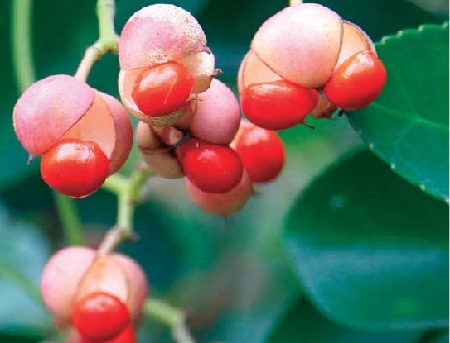The English name for Euonymus japonicus is “Japanese euonymus” or “Japanese spindle.” Is Euonymus japonicus poisonous to humans? Euonymus japonicus, or Japanese euonymus, contains compounds that can be toxic, particularly in its fruits and seeds. The plant contains substances known as cardiac glycosides, which can have adverse effects on the cardiovascular system. Consumption of these parts of the plant can lead to symptoms such as nausea, vomiting, abdominal pain, diarrhea, and, in severe cases, more serious complications.
It’s important to note that while the toxicity is present, significant or life-threatening poisonings from Euonymus japonicus are relatively rare. However, caution should still be exercised, especially in households with children or pets. If there is any suspicion of poisoning from Euonymus japonicus or any other plant, it is essential to seek medical attention immediately. In case of accidental ingestion, contact your local poison control center or emergency medical services.

Due to the potential toxicity of Euonymus japonicus, it is advisable to plant it in areas where there is limited access for children and pets. Additionally, if you have concerns about the plant’s toxicity, especially if you have children or pets, it might be worth considering alternative non-toxic plants for your garden. Always be cautious and informed when it comes to introducing potentially toxic plants into your living space.
Where is Euonymus japonica used?
Euonymus japonicus, commonly known as Japanese euonymus or Japanese spindle, is a versatile shrub that is used in various landscaping applications. Here are some common uses of Euonymus japonicus:
- Hedging and Screening:
- Euonymus japonicus is frequently used to create hedges and screens in gardens and landscapes. Its dense growth habit and ability to tolerate pruning make it well-suited for this purpose.
- Topiary and Shaping:
- The plant’s malleability allows for creative pruning and topiary shaping. It can be trained into various forms, adding a decorative element to gardens.
- Foundation Planting:
- Japanese euonymus is often used in foundation planting around homes and buildings, providing a green backdrop and adding visual interest.
- Mixed Borders:
- It can be incorporated into mixed borders with other shrubs and perennials to create a diverse and visually appealing landscape.
- Coastal Gardens:
- Some varieties of Euonymus japonicus are known for their tolerance to salt spray, making them suitable for planting in coastal gardens.
- Containers and Planters:
- Dwarf varieties or those with variegated foliage can be used in containers and planters, adding greenery to patios, decks, or balconies.
- Erosion Control:
- Due to its dense growth habit, Japanese euonymus can be used on slopes and banks for erosion control.
- Formal Gardens:
- In formal garden designs, Euonymus japonicus can be used for geometric layouts, hedging, or to create defined shapes.
- Low-Maintenance Landscapes:
- Once established, Japanese euonymus is relatively low maintenance, making it suitable for landscapes where ease of care is a priority.
- Variegated Cultivars for Ornamental Use:
- Variegated cultivars, such as ‘Silver King’ and ‘Aureomarginatus,’ are specifically valued for their ornamental qualities and are used for aesthetic purposes in gardens.
While Euonymus japonicus has numerous landscaping applications, it’s important to consider the potential invasiveness of some varieties in certain regions. Always check with local authorities or gardening experts to ensure that you are selecting a cultivar that is well-suited to your area and won’t become invasive.
